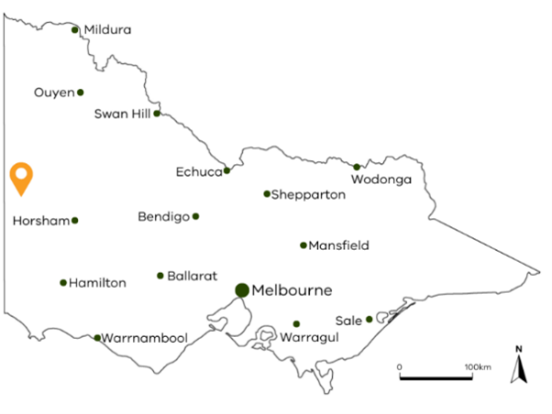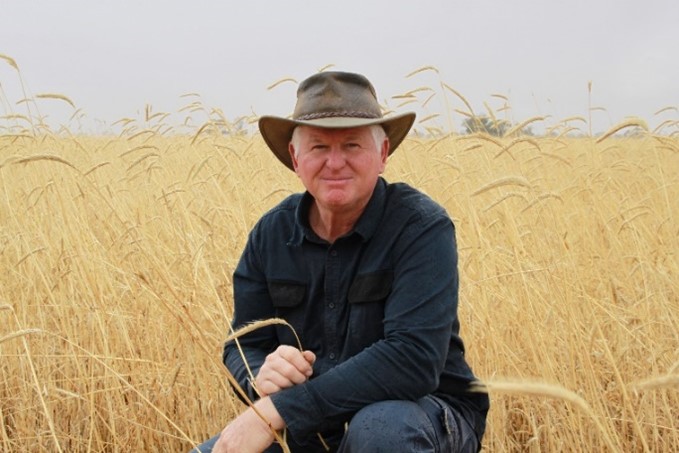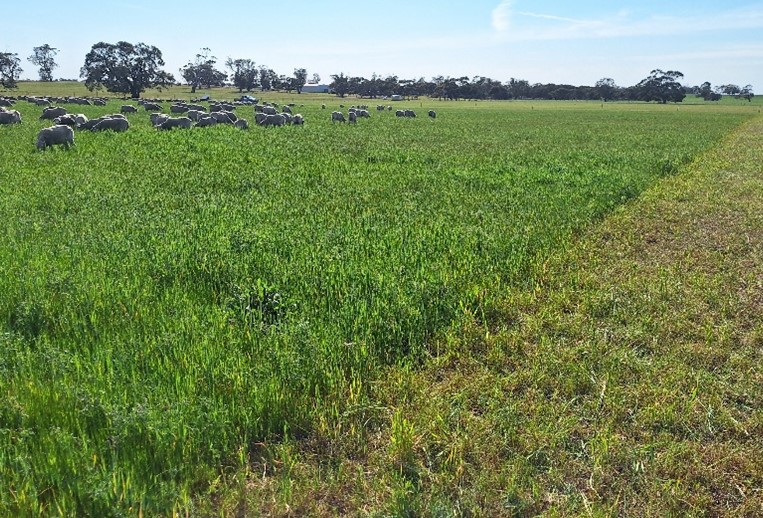Growing carbon on a Wimmera sheep and cropping farm

About Yarrock Farm
- Steven Hobbs and family run a mixed farming business of sheep and cropping in the Wimmera, about 18 km north-west of Kaniva in western Victoria.
- Yarrock Farm consists of 800 ha which includes approximately 700 head of self-replacing Merino ewes, which are mated to Merino rams in November.
- There was 343 ha of cropping where in 2022 this was 64% cereal, 26% legume and 10% oilseed crops.
- Soil types across the farm are a mixture of low-lying swampy flats, reds soils and shallow loamy soils over clay.
- The farm has an average annual rainfall of 353 mm.
- There are scattered mature trees within some paddocks that total 20 ha.
- The Hobbs’ have progressively shifted emphasis from cropping to grazed perennial pastures where there is focus on using sheep electronic identification and liveweight and fleece weight monitoring to increase productivity.
- Strict grazing management helps maintain pastures and build soil carbon.
Farming and carbon emissions
In Australia, there’s a big focus on how farms manage greenhouse gas (GHG) emissions and store carbon. Efficient production to manage and reduce emissions is becoming increasingly important.
Agriculture Victoria’s On-Farm Emissions Action Plan Pilot is working with Victorian farmers to know, understand, and act on their farm GHG emissions.
‘Implementing changed grazing management, I was curious to investigate what effect the carbon that had been sequestered in the soil, would have on our overall farm emissions’, said Steven.
The Hobbs family got really interested in how they could increase the carbon in their soil. This led them to join a soil carbon project in 2017, where they started measuring their soil and changing how they managed their grazing.
They saw the Agriculture Victoria Pilot program as a great chance to get some numbers on their farm’s emissions and see if the soil organic carbon was helping to balance those emissions.
Yarrock Farm is located between the Great Mallee Desert and Kanes Swamp. It used to be part of the larger historic Yarrock Station. Steven is the fourth generation on the farm and wants to keep improving the farming systems to adapt to changing climate conditions and market opportunities.

‘A series of dry years and a succession of late frosts has seen the cropping rotation slashed to mitigate frost damage effects’, said Steven.
Steven also thinks about how his ancestors grew their own fuel, like oaten hay for the horses that pulled their equipment. He wonders how a decentralized (circular) energy system could work on a modern farm. Steven is very interested in renewable fuels and has tried using an oil crushing plant on his farm.
‘I believe that agriculture needs to dramatically reduce its dependence on fossil fuels’, said Steven.
The current emphasis is to increase soil organic carbon, where Steven said, ‘This has been enabled through making management changes that broaden landscape function, including mixed species plantings, rotational grazing, regeneration and planting of perennial pastures’.

They are also improving sheep production by using Australian Sheep Breeding Values (ASBVs) and genetics to breed more fertile and faster-maturing sheep. They use electronic identification (EID) technologies to keep track of sheep performance.
To optimize feed for their sheep, they use rotational grazing with mobile water supplies and temporary fencing. They have trailer-mounted solar-powered pumps and energizers to deliver water with low emissions and allow timely grazing across the farm.
Know Your Number
‘Know Your Number’ is a way to measure the greenhouse gas (GHG) emissions from a farm using a special tool like the Greenhouse Accounting Framework (GAF) calculator.
This number is the total amount of carbon dioxide equivalents (CO2-e) produced by the farm each year. It includes 3 types of emissions, called scopes:
- Scope 1: Emissions from livestock (like enteric methane from sheep and cows), nitrous oxide from nitrogen fertilizer application, urine and dung and carbon dioxide from fossil fuel use.
- Scope 2: Emissions resulting from the electricity the farm uses.
- Scope 3: Emissions created in manufacturing products the farm buys (embedded).
Farms can also capture and store carbon in trees and soils, a process known as carbon sequestration. This captured carbon can be used to balance against their emissions, which is called ‘insetting’.
In 2022, the Hobbs’ farm found that 73% of their emissions came from the enteric methane produced by their sheep. Carbon dioxide from energy, fuel, lime and urea made up 1.5% of emissions for livestock and 6% for crops. Nitrous oxide from fertilizer, leaching, run-off, urine, and dung made up 4% of the total emissions.
Emissions from products the farm buys (Scope 3) accounted for 9% of the total emissions. The farm’s soil captured (sequestration) 622 tonnes of CO2-e per year from 2017 to 2022.

The soil carbon capture rate was helped by the low initial soil carbon, switching from crops to perennial pasture, and recent higher rainfall. They will keep testing the soil to see long-term trends. The 20 ha of mature trees on the farm only reduced emissions by 1% because they grow slowly.
Overall, the farm captured 110 tonnes of CO2-e in 2022.
I was delighted to learn that across the farm in 2022 that there was a net sequestration of 110 tonnes CO2-e, and that this has been achieved from increasing soil organic carbon across 15% of my farm area.
Emissions intensity measures emissions per unit of product. The Hobbs farm’s emissions intensity for lamb was 6.8 kg CO2-e per kg of liveweight, which is among the lowest 25% of farms benchmarked in the Livestock Farm Monitor Project in 2022/231.
For wool, it was 25.5 kg CO2-e per kg of greasy wool, also below average and just above the lowest quartile in the Livestock Farm Monitor Project in 2022/23. With soil and tree carbon capture, the farm’s wool and sheep meat production was carbon neutral in 2022.
Acting to reduce emissions
Steven wants to know how much carbon is being stored in the soil below 30 cm, as current sequestration estimates only look at the top 30 cm.
For the Hobbs’ farm, a key goal is to increase the areas where soil organic carbon is improved. They are doing this by expanding the areas where they can use rotational grazing. A Pilot Action Plan Grant is helping them build another trailer with solar-powered pumps and an electric fence energizer.
This will make it easier to set up temporary fencing and water supplies for rotational grazing over a larger part of the farm.

The future
Steven believes that improving soil organic carbon in low-carbon soils will help reduce the farm’s emissions in the future through additional in-setting. To do this, it’s important to measure and monitor the soil regularly to ensure accurate carbon accounting.
Science shows that soil’s ability to absorb carbon will slow as it reaches a new balance when switching from crops to perennial pastures. Seasonal conditions will also affect how much carbon the soil can store, which is why regular and thorough soil tests are essential to track changes over time.
Improving production efficiency by optimizing livestock genetics and planting more trees as shelter belts are other ways to reduce the farm’s overall emissions.
You can’t manage what you don’t measure.
Finally, regarding the Pilot program and the future, Steven said, ‘Undertaking and completing a Farm emission analysis is a very important first step in understanding where and what emissions are being generated in the various enterprises in your farm business. Once you know this, you can then look at implementing low cost and low risk actions to reduce your overall emissions. You can’t manage what you don’t measure’.
This case study is part of a series outlining practical actions Victorian farmers are implementing on farm as part of the Agriculture Victoria, On-Farm Emissions Action Plan Pilot program.
Acknowledgements
Author – James Nuttall, Agriculture Victoria, 2024
For further information on the project email actionplanpilot@agriculture.vic.gov.au
The On-Farm Emissions Action Plan Pilot is part of the Victorian Government’s Agriculture Sector Emissions Reduction Pledge to provide practical information, tools and services to support farmers to understand and reduce emissions.
The Pilot will work with up to 250 farm businesses across the state to estimate their on-farm emissions profile and identify potential actions to manage and reduce emissions while maintaining productivity and profitability.
References
1. Greenhouse Gas Farm Monitor Victoria Annual Report 2022-23 ![]() [PDF File - 2.5 MB].
[PDF File - 2.5 MB].
Agriculture Victoria has a fact sheet for landowners on some of the key questions to consider when exploring carbon sequestration projects.
Learn more about soils and carbon for reduced emissions